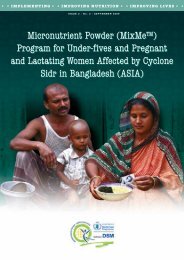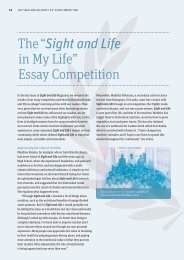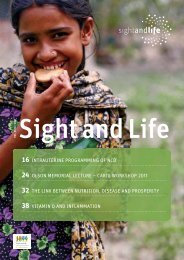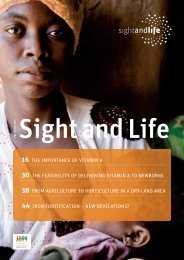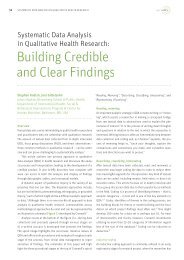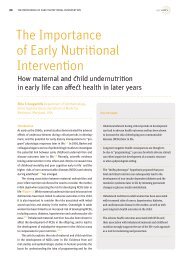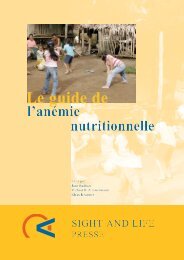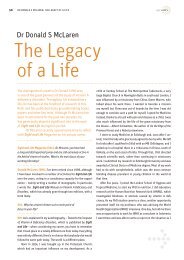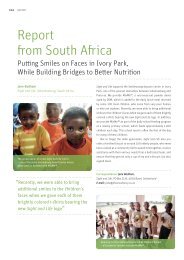Newsletter 02 2006.pdf - Sight and Life
Newsletter 02 2006.pdf - Sight and Life
Newsletter 02 2006.pdf - Sight and Life
You also want an ePaper? Increase the reach of your titles
YUMPU automatically turns print PDFs into web optimized ePapers that Google loves.
SIGHT AND LIFE 20<br />
NEWSLETTER 2/2006<br />
enzymes (the so-called “knock<br />
out” mouse) to draw inferences<br />
about pathways in carotene<br />
metabolism. Geneticist created<br />
knock-out animals, deprived of<br />
or suppressed regarding one or<br />
another receptor. These proved<br />
to be strong investigative tools<br />
to use in pursuing the role of<br />
transporters in carotene uptake.<br />
In concluding his talk, Dr Harrison<br />
summarized a series of Beltsville<br />
laboratory experiments using<br />
receptor inhibitors, knock-out<br />
mice <strong>and</strong> their combination, to<br />
illustrate a partial dependency of<br />
carotene uptake on this class of<br />
membrane-associated enzyme<br />
as the basis for facilitated cellular<br />
uptake of carotenoids in the<br />
intestine.<br />
Dr Kathleen C Ellwood, of the<br />
Center for Food Safety <strong>and</strong> Applied<br />
Nutrition (CFSAN) of the<br />
Food <strong>and</strong> Drug Administration<br />
(FDA) of the United States presented<br />
the topical theme Reviewing<br />
the Scientific Evidence for<br />
Health Claims. Dr. Ellwood is assigned<br />
to the Division of Nutrition<br />
Programs <strong>and</strong> Labeling, Office<br />
of Nutritional Products Labeling<br />
<strong>and</strong> Dietary Supplements of the<br />
CFSAN. She provided a lucid<br />
exposition of the United States<br />
government’s oversight <strong>and</strong> regulation<br />
in the food-labeling area,<br />
<strong>and</strong> participated in a lively <strong>and</strong><br />
interactive question <strong>and</strong> answer<br />
period thereafter. Need for labeling<br />
rules came about with the<br />
expansion of knowledge about<br />
bioactive substances in foods<br />
(of which the various carotenoids<br />
are examples). There came an<br />
effort by manufacturers of foods<br />
<strong>and</strong> supplements in the United<br />
States to transform findings into<br />
claims of beneficial effects. This<br />
led producers <strong>and</strong> marketers to<br />
seek to make claims about the<br />
benefits of consumption of the<br />
substances, the food containing<br />
the substances or both. To the<br />
extent that foods <strong>and</strong> substances<br />
are offered as remedies <strong>and</strong><br />
therapies, a specific regulatory<br />
Kathleen C Ellwood<br />
h<strong>and</strong>ling comes into play. Dr.<br />
Ellwood correctly presented this<br />
as a case example of the merger<br />
of science with policy.<br />
Claim statements for a product<br />
are a form of “speech”; within<br />
the United States of America,<br />
freedom of speech is protected<br />
by the First Amendment to the<br />
Constitution. Provisions for making<br />
claims for health regarding a<br />
retail product are now covered by<br />
legislation (statutes) <strong>and</strong> the judicial<br />
precedents (case law). The<br />
FDA considered disease therapy<br />
claims for foods in the 1970s <strong>and</strong><br />
1980s, <strong>and</strong> concluded that food<br />
must be treated by the same<br />
st<strong>and</strong>ards as any drug.<br />
Since that era, however, emerging<br />
scientific discovery has shown a<br />
series of more subtle diet-health<br />
relationships including protection<br />
<strong>and</strong> preservation of wellbeing<br />
<strong>and</strong> function. U.S. consumers<br />
were interested in seeking the<br />
potential benefits from dietary<br />
factors, <strong>and</strong> there was marketing<br />
pressure to deliver what the<br />
consumer dem<strong>and</strong>ed. This led to<br />
the passage in 1990 of the Nutrition<br />
Labeling <strong>and</strong> Educational<br />
Act, which governs the nature of<br />
claims that could be attached to<br />
edible products. It was not about<br />
treating established disease, i.e.<br />
the drug action, but rather about<br />
“Health Claims”. The act regulated<br />
claims of causal relationships<br />
between a food substance<br />
<strong>and</strong> a disease or health-related<br />
condition in the general US<br />
population or sub-population, in<br />
which consumption could reduce<br />
their risk. For the Health Claim to<br />
be approved the st<strong>and</strong>ard was<br />
“significant scientific agreement”,<br />
that is a strong consensus of a<br />
causal relationship.<br />
The speaker recounted how<br />
manufacturers felt constrained<br />
by having to get over such a high<br />
bar; they brought suits in court<br />
claiming that the Act infringed<br />
upon the First Amendment guarantee<br />
of freedom of speech. This<br />
has led, since 1999, to a secondary<br />
level of regulation for labeling,<br />
the so-called Qualified Health<br />
Claim (QHC). These claims include<br />
qualifying language in order<br />
to prevent the consumer from being<br />
misled. QHCs are applied for<br />
relationships such as that relating<br />
lycopene or lycopene-containing<br />
foods to reduced risk of prostate<br />
cancer <strong>and</strong> similar assertions.<br />
The process of evaluation by the<br />
FDA for a QHC has a defined<br />
set of steps. The first is literature<br />
review <strong>and</strong> selection. Animal<br />
studies are not relevant. Insofar<br />
as observational studies can<br />
indicate association, but not causality,<br />
the most relevant literature<br />
is considered to be that from intervention<br />
trials. The interventions<br />
can have outcomes of reduced<br />
incidence of disease/condition<br />
or favorable modification of a<br />
validated modifiable risk factor<br />
related to ill health.<br />
San Francisco’s famous cable<br />
cars.



